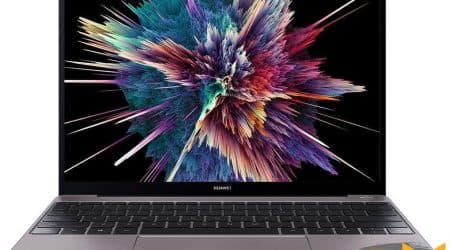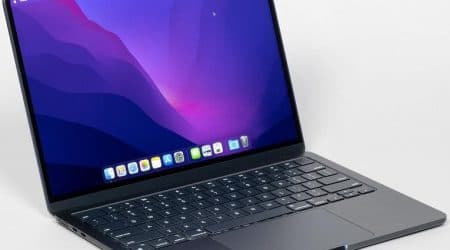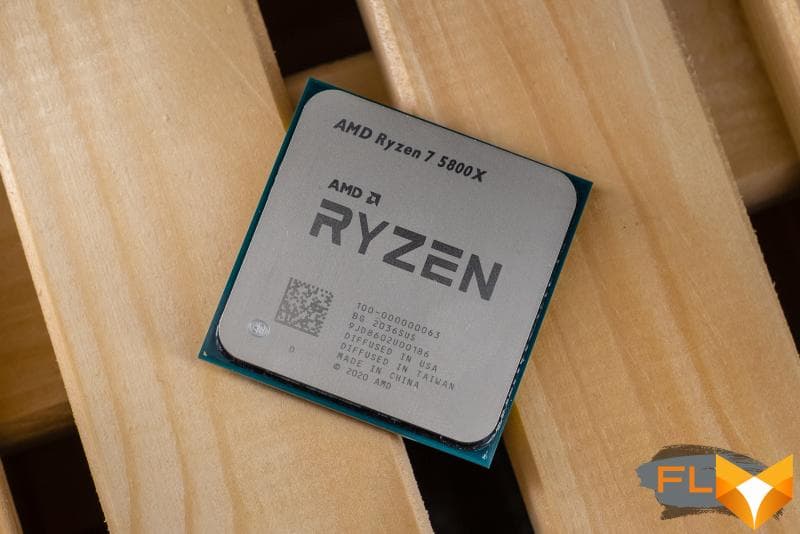


We started our introduction to AMD processors based on the Zen 3 microarchitecture with the older members of the Ryzen 5000 family – the 12-core Ryzen 9 5900X and the 16-core Ryzen 9 5950X. It was these models that we first received from the manufacturer for tests, but perhaps they were not the best candidates to get a basic idea of the advantages of the new generation of AMD CPUs. In addition to the fact that the Ryzen 9 5950X and 5900X are among the elite offerings with a rather impressive cost, they are burdened with a multi-chip structure: they include two equal semiconductor crystals with processor cores and a third crystal responsible for I / O functions. This not only makes them more difficult objects to study, but also has an ambiguous effect on functionality. In particular, the L3 cache of such processors consists of two separate segments; delays in internuclear interaction differ depending on whether we are talking about nuclei in one crystal or in neighboring ones; and the Infinity Fabric bus, which is responsible for connecting the components of the CPU into a single whole, is heavily loaded with inter-chip traffic.
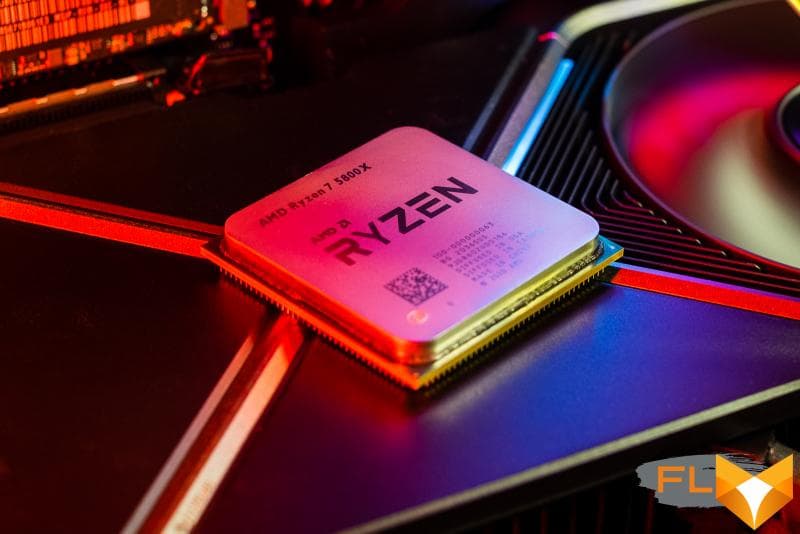
As for the Ryzen 7 5800X, it is not only a simple and efficient implementation of the Zen 3 microarchitecture in a consumer CPU, but also one of the most suitable options for the mainstream user, which offers 8 cores and 16 threads – enough power for resource-intensive applications and games with good reserve for the future. Moreover, in addition to an attractive core formula, this processor can offer impressive clock speeds multiplied by the highest IPC among x86 desktop processors.
The only problem with the Ryzen 7 5800X is its price. Even at the official price, it is only $100 cheaper than the 12-core Ryzen 9 5900X, which translates into a frankly inflated cost per core. While one core of an eight-core processor is estimated by the manufacturer at about $56, in a 12-core or six-core processor, each core will cost the user $46 or $50, respectively, which causes some misunderstanding even at the first acquaintance with the Ryzen 7 5800X. It appears that selecting defect-free octa-core Zen 3 chips capable of operating at high frequencies is a problem for AMD at this stage, and the company, having raised the price bar, wants to artificially limit demand for the Ryzen 7 5800X and redirect consumer attention to those models which use chiplets with deactivated cores.
However, talking about the principles of compiling an official price list is a rather pointless exercise, since the real prices of representatives of the Ryzen 5000 series in retail are not determined by it at all, but by the level of demand, which is many times greater than the meager supply that AMD was able to provide retail.
Nevertheless, sooner or later the problems with underdeliveries will be solved, and by this moment it is necessary to prepare accordingly. In this review, we will see how confident AMD’s next-generation eight-core looks, which, according to the original idea, was supposed to become a competitor for the older LGA1200 Intel Comet Lake processors.
⇡#Ryzen 7 5800X more
The Ryzen 7 5800X is the mid-range processor in the Vermeer family based on the Zen 3 microarchitecture and features two semiconductor dies: a 7nm CCD chiplet with eight processing cores and a 12nm I/O chiplet that houses memory controllers and PCI Express, as well as other external interfaces are implemented. Given the support for SMT technology, this processor is characterized by the 8/16 nuclear formula, which makes it the ideological follower of the Ryzen 7 3800X with a new microarchitecture. But there is an important nuance: in Zen 3, CCX processor complexes began to combine eight cores at once, which means that the Ryzen 7 5800X, unlike its predecessor, is a topologically monolithic eight-core, in which all cores are absolutely equal in relation to each other , and the 32 MB L3 cache is a single entity and fully accessible to each individual core.
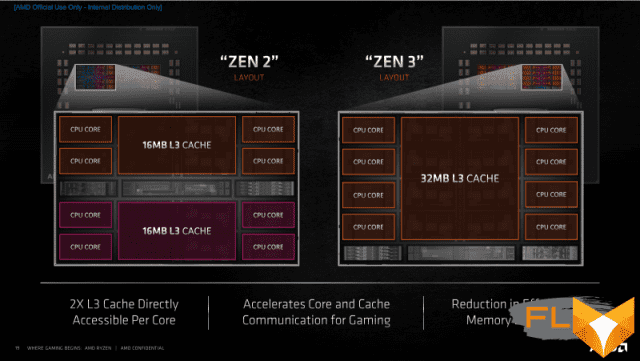
The Ryzen 7 5800X could be figuratively imagined as half of the 16-core Ryzen 9 5950X we reviewed earlier, but there are noticeable differences in clock speeds between these processors. The base frequency of the Ryzen 7 5800X is 3.8 GHz versus 3.4 GHz for its 16-core counterpart, but the maximum frequency in turbo mode is limited to 4.7 GHz, while the flagship of the Ryzen 5000 family is officially allowed to automatically overclock to 4.9 GHz .

However, the real frequencies of AMD processors are very different from the passport ones. On the one hand, under full multi-threaded load, they run faster than specified. On the other hand, the frequency with a single-threaded load in the new generation also got the opportunity to exceed the limit recorded in the specifications. To get a real picture, we looked at what frequency our instance of the Ryzen 7 5800X was running in the Cinebench R23 rendering test with a load of different numbers of threads. The results of this experiment are shown in the graph.
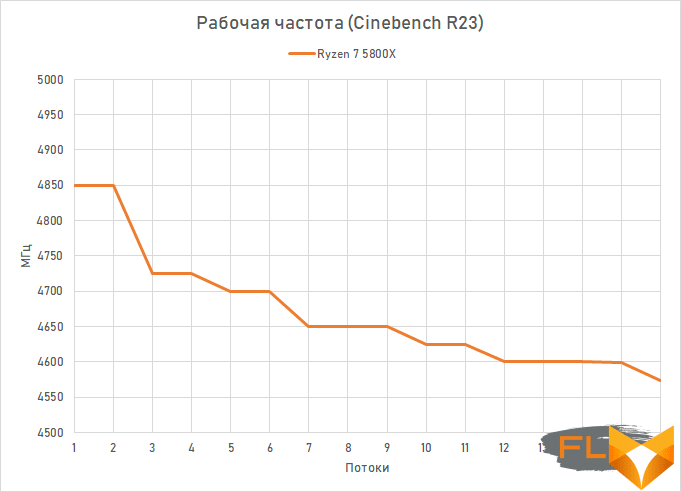
It turns out that the Ryzen 7 5800X is quite free to take the frequency of 4.85 GHz when a single core is running, and at maximum rendering load, its frequency is maintained at 4.55-4.6 GHz. That is, in practice, this is a processor whose real frequencies are quite close to the frequencies of the older Comet Lake. The progress compared to the Ryzen 7 3800XT is huge here: the new product has added from 200 to 400 MHz.
The Ryzen 7 5800X is priced at $450 by the manufacturer, which means it costs significantly more than other modern eight-core enthusiasts – AMD Ryzen 7 3800X and Intel Core i7-10700K. However, it also offers more advanced features, as can be seen from the table.
| Ryzen 7 5800X | Ryzen 7 3800XT | Core i7-10700K | Platform | Socket AM4 | Socket AM4 | LGA1200 | Microarchitecture | Zen 3 | Zen 2 | Skylake | Technical process, nm | 7/12 | 7/12 | 14 | Cores/Threads | 8/16 | 8/16 | 8/16 | Frequency (nominal/turbo), GHz | 3.8-4.7 | 3.9-4.7 | 3.8-5.1 | L3 cache, MB | 32 | 2 × 16 | 16 | TDP, W | 105 | 105 | 125 | Memory | DDR4-3200 | DDR4-3200 | DDR4-2933 | PCIe lanes | 24 × Gen4 | 24 × Gen4 | 16 × Gen3 | Integrated graphics | No | No | Yes | Price | $449 | $399 | $374 |
Even without going into details, it is immediately clear that the Ryzen 7 5800X outperforms the competitor from the blue camp in terms of L3 cache size and the functionality of the PCIe controller, which AMD has long switched to the fourth version of the protocol. But most importantly, with the transition to the Zen 3 microarchitecture in AMD processors, the specific performance has noticeably increased: at the same frequency, the Ryzen 7 5800X should be faster than the Ryzen 7 3800XT by an average of 19%. With that in mind, AMD’s new octa-core really seems like a much more interesting option.

In addition, Zen 3 also corrects another serious shortcoming of previous AMD designs – high inter-core communication latencies, thanks to which the Ryzen 5000 series processors immediately perked up in games. In the octa-core processor we are considering today, this should be especially obvious, because the Ryzen 7 5800X includes only one CCD chip and, in accordance with the changes made in the new microarchitecture, only one CCX complex. Thus, the not too fast Infinity Fabric bus in this processor is not used at all for inter-core communication, it is needed only for connecting the CCD chiplet with the memory controller and external interface controllers.
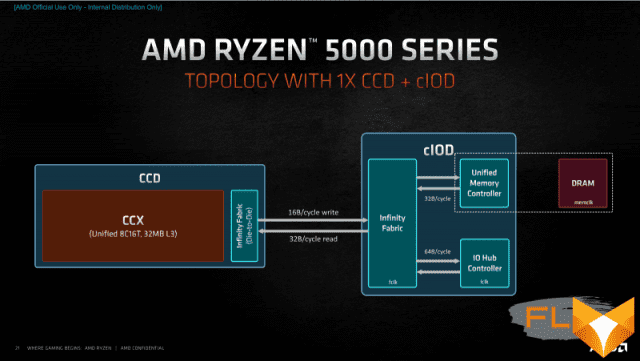
This not only improves processor efficiency with its own L3 cache, with all 32 MB available to any core without any additional latency, but also improves memory efficiency, since the Infinity Fabric bus is free of inter-CCX traffic. In the end, it turns out that in terms of the efficiency of the entire memory subsystem, the Ryzen 7 5800X turns out to be better than Intel processors, offering both more cache at the second and third levels, and lower latency. Modern members of the Core family benefit slightly only in terms of memory access delays, since the memory controller in Zen 3 remained separated from the processor die.
To illustrate this, the following graphs compare latencies when working with different memory block sizes for the Ryzen 7 5800X and Core i7-10700K, running at the same frequency of 4.0 GHz with the same dual-channel DDR4-3600 memory.
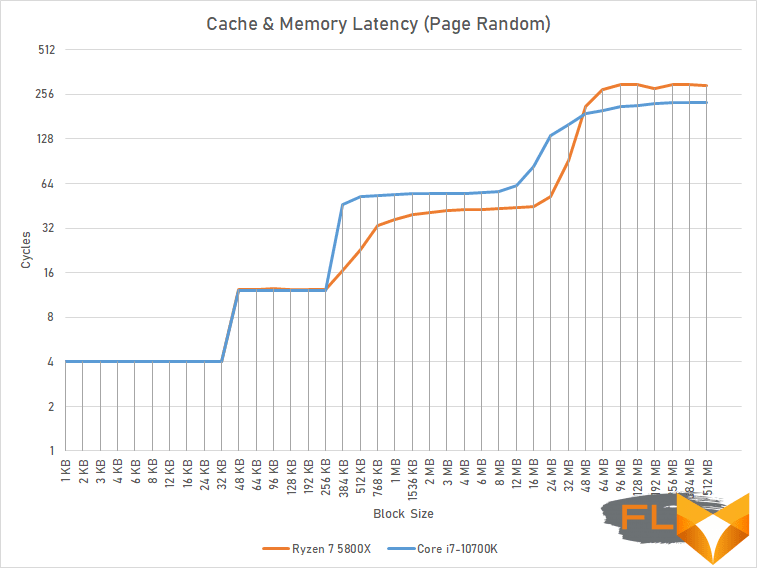
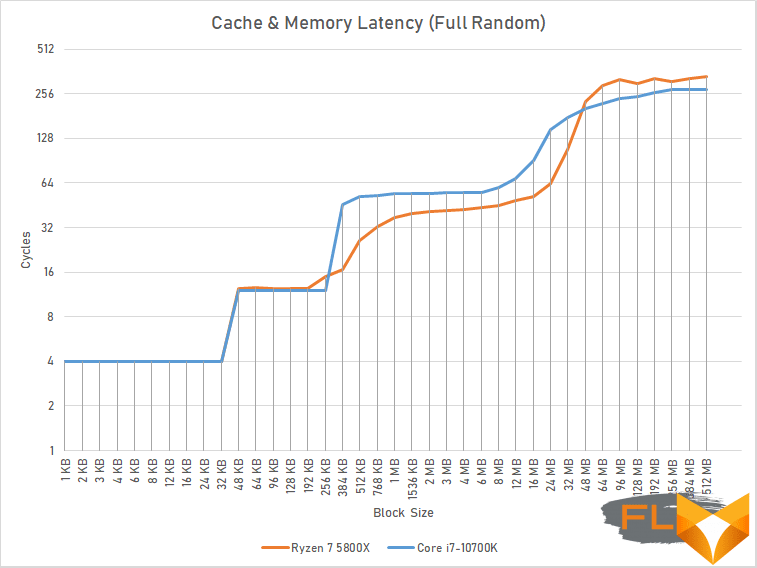
Incredible but true: the cache memory subsystem in the Ryzen 7 5800X really works more efficiently than the Core i7-10700K, although it was very difficult to believe in the possibility of this before. At the same time, you should not be upset about memory latency either: a giant monolithic 32 MB L3 cache, which AMD managed to implement thanks to the use of a “thin” 7-nm process technology, in most cases compensates for not the fastest memory subsystem, and the fact that recording in memory for processors with one CCD is carried out over a 16-byte wide bus, that is, at twice the speed as reading.
Even though the Ryzen 7 5800X only has a single CCD semiconductor die, this processor is assigned the same 105W TDP as the dual CCD Ryzen 9. The maximum power consumption of the eight-core specification is also 142 watts. This allows AMD to use the hottest silicon with the highest leakage currents in the Ryzen 7 5800X.
At one time, we called the eight-core Ryzen 7 3800X the champion in heating, because it was distinguished by very high operating temperatures even when operating in nominal mode. The new Ryzen 7 5800X is its worthy heir. A simple example: during testing in Cinebench R23, we observed processor die temperatures of up to 85-90 degrees, despite the fact that a custom liquid cooling system based on EKWB components with a 360mm radiator was used to remove heat from the CPU. And this, recall, is the nominal mode, for which 90 degrees is the maximum allowed by the specification.

Of course, this does not mean that with weaker cooling systems, the Ryzen 7 5800X overheats. No, this is not happening. As part of the Precision Boost technology, the temperature limit is triggered and the processor simply slows down the frequency, slightly reducing its performance. In addition, Cinebench R23 is a multi-threaded resource-intensive task, and if we talk about scenarios more familiar to the mass user, for example, about games, then such frightening heating, of course, is not observed. Although we noted 85-degree peaks during gaming tests.
Not surprisingly, the high operating temperatures inherent in the Ryzen 7 5800X forced AMD to refuse to bundle it with a stock cooler. Even the boxed version lacks a cooler, and you should definitely keep this point in mind when planning an assembly based on Socket AM4-octa-core.
⇡#Overclocking
To tell the truth, it’s hard to expect any overclocking records from a processor operating at 90 degrees nominal. This is exactly what was confirmed when trying to manually overclock: it is almost impossible to achieve stable operation from such a CPU without overheating at frequencies that are any noticeably higher than the nominal ones.
Based on the stability check in Prime95, the program we always use to create the maximum processor load, the maximum achievable overclocking result for our instance of the Ryzen 7 5800X was 4.55 GHz.

Stable operation at this frequency was achieved at a supply voltage (according to monitoring data) of 1.225 V. In the BIOS, a voltage of 1.25 V was selected and the third level of Load-Line Calibration was selected. And this is the limit: with a further increase in frequency, stability was lost, and with an increase in voltage, the CPU overheated, followed by an emergency shutdown of the system.
It is especially surprising that the processor heat reached almost 100 degrees at a relatively low voltage, and even despite the fact that a fairly efficient liquid cooling system was responsible for heat removal. However, in high temperatures, it is clearly not the insufficient heat sink performance that is to blame, but rather the fact that heat has to be removed from a 7-nm crystal with a very small area – 80.7 mm2.
In fairness, it should be noted that compared to the same 12- and 16-core processors, the eight-core Ryzen 7 5800X overclocks 100-200 MHz better. The Ryzen 7 5800X also showed a higher result compared to its eight-core predecessor with the Zen 2 microarchitecture. TSMC’s Zen 3 dies are being gradually improved, and this can be seen, but representatives of the Ryzen 5000 series still cannot compete in overclocking performance with Intel processors. can.
And in general, it turns out that almost the same frequency that is obtained as a result of overclocking manually, the processor can automatically reach itself using Precision Boost technology. At the same time, automatic technology is also superior to manual overclocking, because it easily brings the processor to higher frequencies under simple loads. And this means that overclocking using a fixed frequency is impractical from a practical point of view and may be of interest only for setting the silicon limit, and it is most likely pointless to use it to increase performance in real conditions.
In practice, with Ryzen 5000 processors, as with their predecessors, it is better to get by with the Precision Boost Override function, which allows you to change or completely cancel consumption limits. There is another option – to try to edit the voltage curve to reduce consumption and increase the frequency within the specified temperature and electrical limits. The latter functionality is implemented by the new Curve Optimizer BIOS settings section.
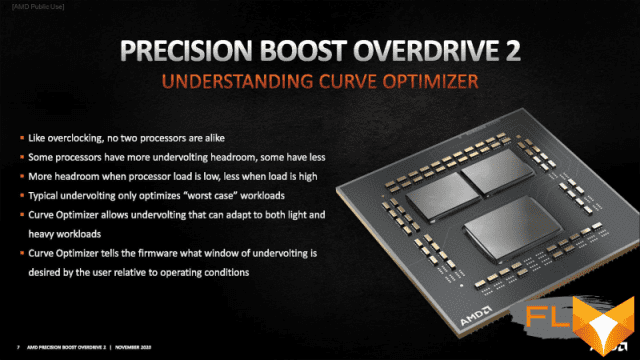
However, even with this approach, one cannot count on any serious increase in frequency. At least for our Ryzen 7 5800X instance, turning on the Precision Boost Override function resulted in a not too noticeable increase in operating frequencies. The graph below, which was built using the Cinebench R23 test, shows the resulting increase in the entire range of loads – from single-thread to 16-thread.
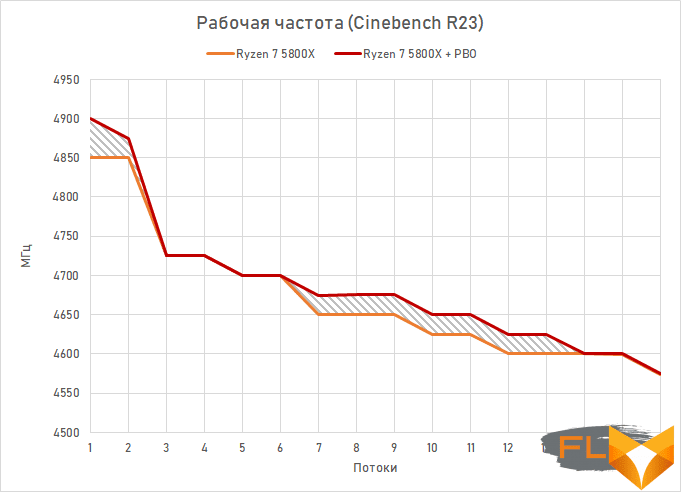
Due to the fact that the Ryzen 7 5800X actually operates at extreme temperatures, its frequency at high loads does not increase from the lifting of consumption limits. However, even with low-flow loads, the increase in frequency is not amazing. Activating Precision Boost Override for an octa-core processor increases the frequency by no more than 50 MHz.
Not too noticeable improvements have been outlined in the direction of synchronous memory overclocking. Unloaded from inter-core traffic, the Infinity Fabric bus connecting the CCD and I / O chiplets in the Ryzen 7 5800X was able to operate at a frequency of 1900 MHz. And this means that with such a processor, the memory can be switched to DDR4-3800 mode while maintaining the synchronism of Infinity Fabric and the memory controller, that is, without getting a performance penalty.
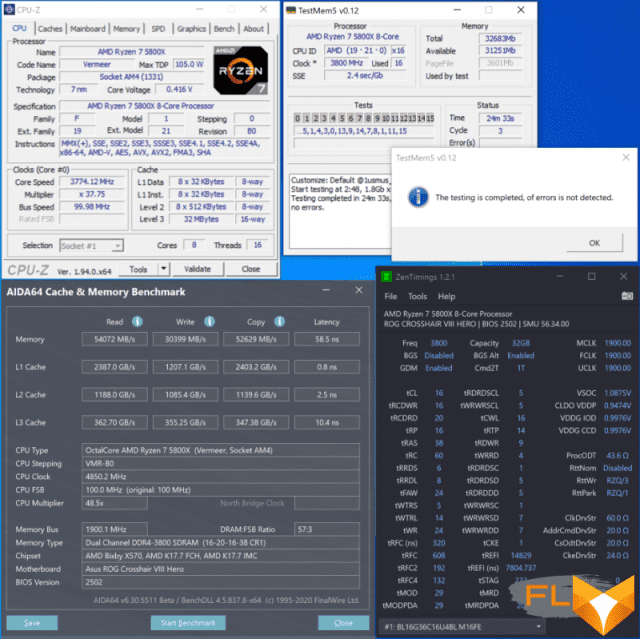
This, of course, is not the DDR4-4000 mode promised by AMD, the possibility of achieving which in synchronous mode remains questionable, but still it is a certain progress compared to what the processors of the previous generation were capable of. In addition, there is hope that with the release of new versions of AGESA, the border of synchronous memory overclocking will still move higher.
⇡#Description of the test system and testing methodology
It seems logical that the Ryzen 7 5800X should first of all be compared with other octa-core processors on the market – AMD Ryzen 7 3800X and Intel Core i7-10700K processors. This will allow you to judge both the performance boost that AMD offers in the new generation of CPUs, and how the new Ryzen 7 5800X looks against the background of a competing processor with the same core formula.
Moreover, for the sake of completeness, we have also added flagship AMD processors with 12 and 16 cores to the diagrams, but you need to keep in mind that in this case they participate in the tests “out of competition”, since they are more expensive than the main characters.
Thus, the test system included the following components:
- Processors:
- AMD Ryzen 9 5950X (Vermeer, 16 cores + SMT, 3.4-4.9GHz, 64MB L3);
- AMD Ryzen 9 5900X (Vermeer, 12 cores + SMT, 3.7-4.8GHz, 64MB L3);
- AMD Ryzen 7 5800X (Vermeer, 8 cores + SMT, 3.8-4.7GHz, 32MB L3);
- AMD Ryzen 9 3950X (Matisse, 16 cores + SMT, 3.5-4.6GHz, 64MB L3);
- AMD Ryzen 9 3900XT (Matisse, 12 cores + SMT, 3.8-4.7GHz, 64MB L3);
- AMD Ryzen 7 3800XT (Matisse, 8 cores + SMT, 3.8-4.7GHz, 32MB L3);
- Intel Core i9-10900K (Comet Lake, 10 cores + HT, 3.7-5.3GHz, 20MB L3);
- Intel Core i9-10850K (Comet Lake, 10 cores + HT, 3.6-5.2GHz, 20MB L3);
- Intel Core i7-10700K (Comet Lake, 8 cores + HT, 3.8-5.1 GHz, 16MB L3).
- CPU cooler: EKWB custom coolant
- Motherboards:
- ASUS ROG Crosshair VIII Hero (Socket AM4, AMD X570);
- ASUS ROG Maximus XII Hero (Wi-Fi) (LGA1200, Intel Z490).
- Memory: 2 × 16GB DDR4-3600 SDRAM, 16-18-18-38 (Crucial Ballistix RGB BL2K16G36C16U4BL).
- Video Card: NVIDIA GeForce RTX 3080 Founders Edition (GA102, 1440-1710/19000MHz, 10GB GDDR6X 320-bit).
- Disk subsystem: Samsung 970 EVO Plus 2TB (MZ-V7S2T0BW).
- Power supply: Thermaltake Toughpower DPS G RGB 1000W Titanium (80 Plus Titanium, 1000W).
All compared processors were tested with the settings accepted by the motherboard manufacturers “by default”. This means that for Intel platforms, the power consumption limits indicated in the specifications are ignored, and instead the maximum possible frequencies are used in order to obtain maximum performance. The vast majority of users operate processors in this mode, since enabling heat dissipation and power consumption limits in most cases requires special BIOS settings. All compared processors were tested with memory operating in DDR4-3600 mode with XMP timing settings.
Testing was performed on the Microsoft Windows 10 Pro (v2004) Build 18363.476 operating system using the following set of drivers:
- AMD Chipset Driver 2.10.13.408;
- Intel Chipset Driver 10.1.31.2;
- NVIDIA GeForce 457.30 Driver
Description of the tools used to measure computing performance:
Comprehensive benchmarks:
- Futuremark PCMark 10 Professional Edition 2.1.2506 – testing in Essentials scenarios (typical work of the average user: launching applications, surfing the Internet, video conferencing), Productivity (office work with a word processor and spreadsheets), Digital Content Creation (digital content creation: editing photos, non-linear video editing, rendering and visualization of 3D models).
- 3DMark Professional Edition 2.14.7042 – testing in the Time Spy Extreme 1.0 scene.
Applications:
- 7-zip 19.00 — archiving speed testing. The time taken by the archiver to compress a directory with various files with a total volume of 3.1 GB is measured. Uses LZMA2 algorithm and maximum compression ratio.
- Adobe Photoshop 2020 21.2.1 – Graphics performance testing. The average execution time of the Puget Systems Adobe Photoshop CC Benchmark 18.10 test script, which simulates the typical processing of an image taken by a digital camera, is measured.
- Adobe Photoshop Lightroom Classic 9.3 – performance test for batch processing of a series of RAW images. The test scenario includes post-processing and export to JPEG at a resolution of 1920 × 1080 and a maximum quality of two hundred 16-megapixel RAW images taken with a Fujifilm X-T1 digital camera.
- Adobe Premiere Pro 2020 14.3.1 – Non-linear video editing performance test. Measures rendering time to YouTube 4K for a project containing HDV 2160p30 footage with various effects applied.
- Blender 2.90.1 – testing the speed of the final rendering in one of the popular free packages for creating three-dimensional graphics. The duration of building the final model pavillon_barcelona_v1.2 from Blender Benchmark is measured.
- Cinebench R23 is the standard benchmark for testing rendering speed in Cinema 4D R23.
- Magix Vegas Pro 18.0 – performance testing for non-linear video editing. Measures rendering time to YouTube 4K for a project containing HDV 2160p30 footage with various effects applied.
- Microsoft Visual Studio 2017 (15.9.28) – measuring the compilation time of a large MSVC project – a professional package for creating three-dimensional graphics Blender version 2.79b.
- Stockfish 12 – testing the speed of the popular chess engine. The speed of enumeration of options in the position “1q6/1r2k1p1/4pp1p/1P1b1P2/3Q4/7P/4B1P1/2R3K1 w” is measured.
- SVT-AV1 v0.8.5 – testing the speed of video transcoding to the promising AV1 format. Performance is measured using a raw 1080p@50FPS AVC video file with a bitrate of about 30 Mbps.
- Topaz Video Enhance AI v1.7.1 – performance testing in an AI-based program to improve video detail. The test uses the original video at 640×360 resolution, which is doubled using the Artemis LQ v7 model.
- V-Ray 5.00 – Benchmark the performance of a popular rendering system using the standard V-Ray Benchmark Next application.
- VeraCrypt 1.24 – cryptographic performance testing. The benchmark built into the program is used, which uses Kuznyechik-Serpent-Camellia triple encryption.
- x265 3.4+26 10bpp – testing the speed of video transcoding to H.265/HEVC format. To evaluate performance, we use the original 2160p@24FPS AVC video file with a bitrate of about 42 Mbps.
Games:
- Assassin’s Creed Odyssey. Resolution 1920 × 1080: Graphics Quality = Ultra High. Resolution 3840 × 2160: Graphics Quality = Ultra High.
- Civilization VI: Gathering Storm. Resolution 1920×1080: DirectX 12, MSAA=4x, Performance Impact=Ultra, Memory Impact=Ultra. Resolution 3840 × 2160: DirectX 12, MSAA = 4x, Performance Impact = Ultra, Memory Impact = Ultra.
- Crysis Remastered. Resolution 1920 × 1080: Graphics Settings = Very High, RayTracing Quality = Very High, Anti-Aliasing = TSAA. Resolution 3840 × 2160: Graphics Settings = Very High, RayTracing Quality = Very High, Anti-Aliasing = TSAA.
- Far Cry New Dawn. Resolution 1920 × 1080: Graphics Quality = Ultra, HD Textures = On, Anti-Aliasing = TAA, Motion Blur = On. Resolution 3840 × 2160: Graphics Quality = Ultra, Anti-Aliasing = Off, Motion Blur = On.
- Hitman 2. 1920 × 1080 resolution: DirectX 12, Super Sampling = 1.0, Level of Detail = Ultra, Anti-Aliasing = FXAA, Texture Quality = High, Texture Filter = Anisotropic 16x, SSAO = On, Shadow Maps = Ultra , Shadow Resolution = High. Resolution 3840 × 2160: DirectX 12, Super Sampling = 1.0, Level of Detail = Ultra, Anti-Aliasing = FXAA, Texture Quality = High, Texture Filter = Anisotropic 16x, SSAO = On, Shadow Maps = Ultra, Shadow Resolution = High.
- Metro Exodus. 1920×1080 resolution: DirectX 12, Quality=Ultra, Texture Filtering=AF 16X, Motion Blur=Normal, Tesselation=Full, Advanced PhysX=Off, Hairworks=Off, Ray Trace=Off, DLSS=Off. Resolution 3840 × 2160: DirectX 12, Quality = Ultra, Texture Filtering = AF 16X, Motion Blur = Normal, Tesselation = Full, Advanced PhysX = Off, Hairworks = Off, Ray Trace = Off, DLSS = Off.
- Shadow of the Tomb Raider. Resolution 1920×1080: DirectX12, Preset=Highest, Anti-Aliasing=TAA. Resolution 3840 × 2160: DirectX12, Preset = Highest, Anti-Aliasing = Off.
- Total War: Three Kingdoms. Resolution 1920 × 1080: DirectX 12, Quality = Ultra, Unit Size = Extreme. Resolution 3840 × 2160: DirectX 12, Quality = Ultra, Unit Size = Extreme.
- Watch Dogs Legion. Resolution 1920×1080: DirectX 12, Quality=Ultra, RTX=Off, DLSS=Off. Resolution 3840 × 2160: DirectX 12, DirectX 12, Quality = Ultra, RTX = Off, DLSS = Off.
- World War Z. 1920 × 1080 resolution: DirectX11, Visual Quality Preset = Ultra. Resolution 3840 × 2160: DirectX11, Visual Quality Preset = Ultra.
In all gaming tests, the results are the average number of frames per second, as well as the 0.01-quantile (first percentile) for FPS values. The use of the 0.01-quantile instead of the minimum FPS is due to the desire to clean up the results from random bursts of performance that were provoked by reasons not directly related to the operation of the main components of the platform.
⇡#Performance in complex tests
In PCMark 10, which evaluates overall PC performance in common user scenarios, the Ryzen 7 5800X results look more than impressive. In cases where the simulated load does not require the use of a large number of computing cores, as, for example, when solving office tasks, the Ryzen 7 5800X even comes out on top, ahead of its more expensive counterparts. In this case, its topology with one CCX plays a positive role, which does not create parasitic delays when cores work with L3 cache.
In a scenario that reproduces the processing of digital content, the Ryzen 7 5800X is naturally inferior to the 12- and 16-core Zen 3 processors of the same generation, but at the same time remains faster than AMD’s multi-core CPUs from the previous generation.
Intel processors also look rather weak against the background of the Ryzen 7 5800X. Even the 10-core flagship Core i9-10900K falls short of the new octa-core Zen 3 microarchitecture in all PCMark 10 scenarios.
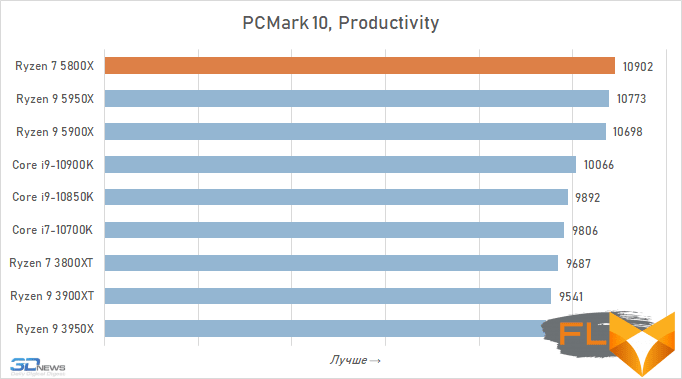
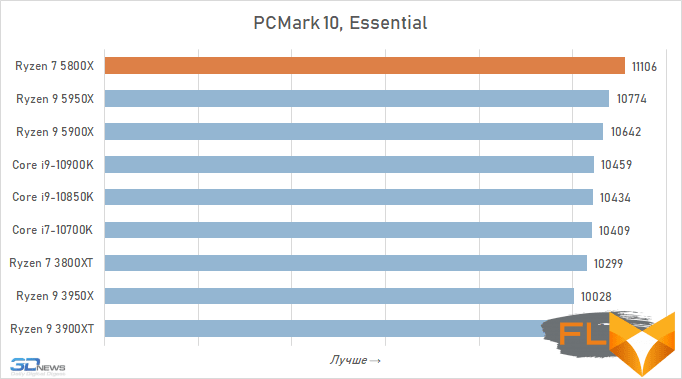
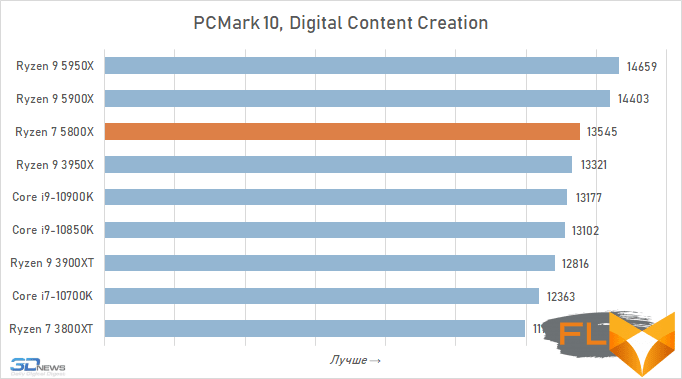
In the 3DMark test, which reproduces some ideal gaming load, the situation is noticeably different. In it, the octa-core Ryzen 7 5800X loses out to any processors with a large number of cores, whether it be Intel CPUs or AMD Zen 2 processors. However, at the same time, among other octa-cores, the Ryzen 7 5800X is definitely the most powerful option. Based on the processor performance index, it outperforms the Ryzen 7 3800XT by 19% and the Core i7-10700K by 8%.
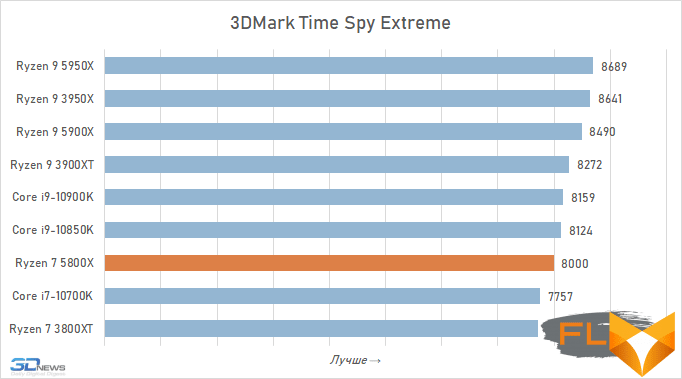
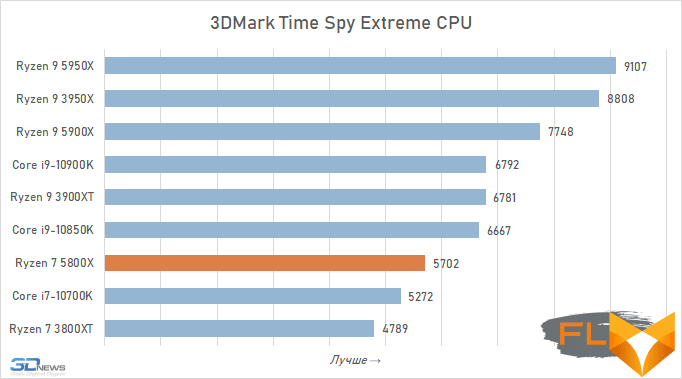
⇡#Performance in Applications
Frankly, the application performance of the Ryzen 7 5800X is no longer as exciting as we experienced with the 12- and 16-core Zen 3 tests. Firstly, the new octa-core processor is far from being the fastest mainstream processor. Secondly, as it turns out, he has worthy competitors in the Intel camp.
It would be foolish to deny that Zen 3 microarchitecture processors have made significant progress in terms of specific performance. This is clearly seen, if only by the fact that the Ryzen 7 5800X is faster than the previous eight-core, Ryzen 7 3800XT, by an average of 17%. However, this is not enough for the eight cores with the new microarchitecture to compete with the 12 cores with the Zen 2 architecture. In resource-intensive tasks, the Ryzen 9 3900XT is still faster than the eight-core novelty: its average advantage is about 9%, except for those applications where the speed of one core plays a significant role.
What’s more, while the Ryzen 7 5800X is definitely faster than the octa-core Core i7-10700K, Intel’s 10-core processors compete quite well against it. If we talk about average performance, then the advantage of the Ryzen 7 5800X over the Core i7-10700K exceeds 15%, but there is some parity with the Core i9-10850K and Core i9-10900K. At the same time, the AMD eight-core can boast a clear superiority in image processing or video rendering in Vegas Pro, but at the same time, Intel’s ten-cores are faster at encryption, machine learning or rendering 3D models.
In other words, from the point of view of an abstract user without specific preferences in the field of resource-intensive software, the Ryzen 7 5800X is a kind of analogue of the Core i9-10900K in terms of speed. Actually, this is exactly what AMD itself tells us with the cost installed on its processor: the Ryzen 7 5800X is priced similarly to the Core i9-10850K precisely because it shows approximately the same performance.
Rendering:
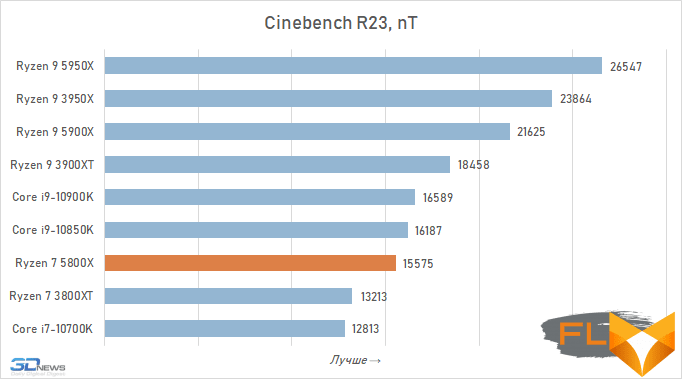
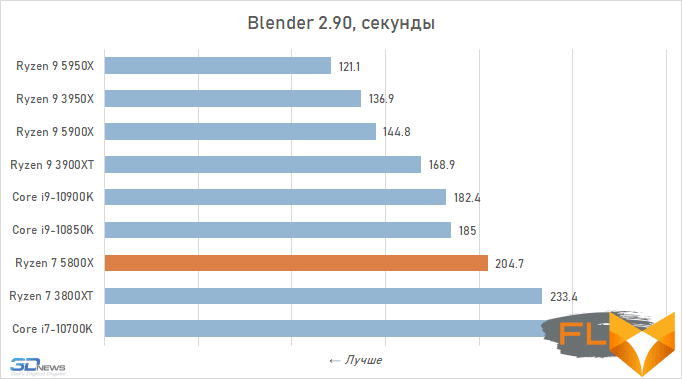
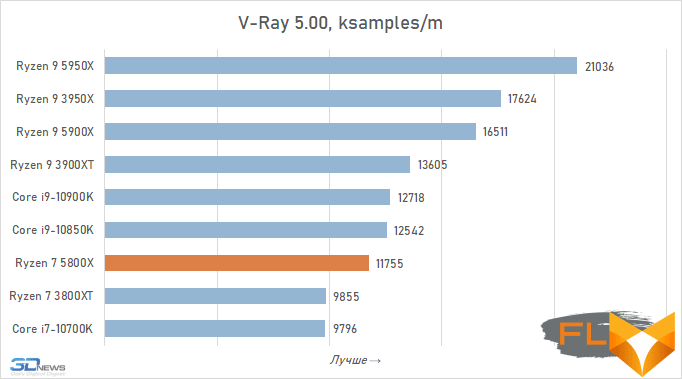
Photo processing:
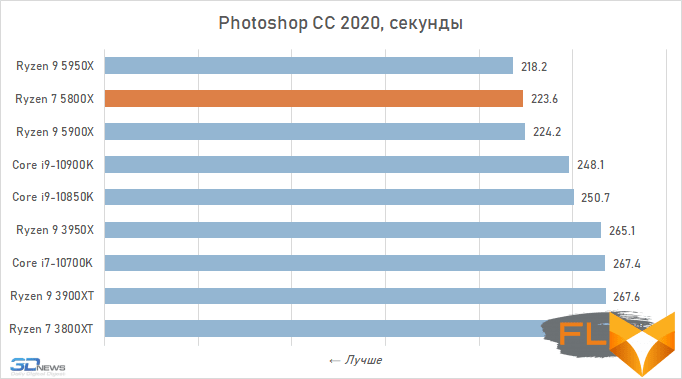
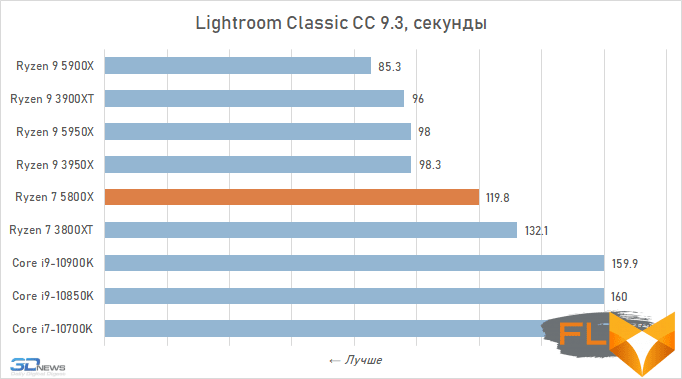
Video work:
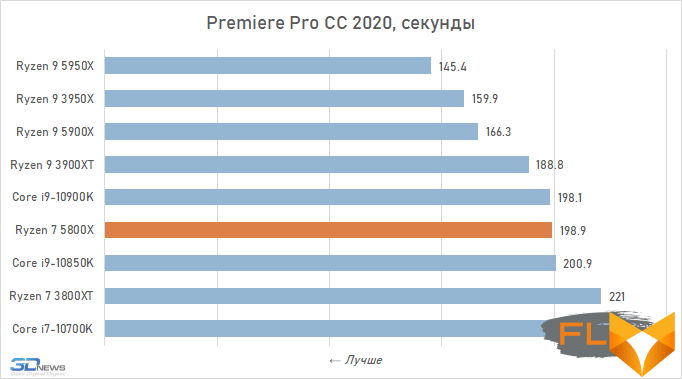
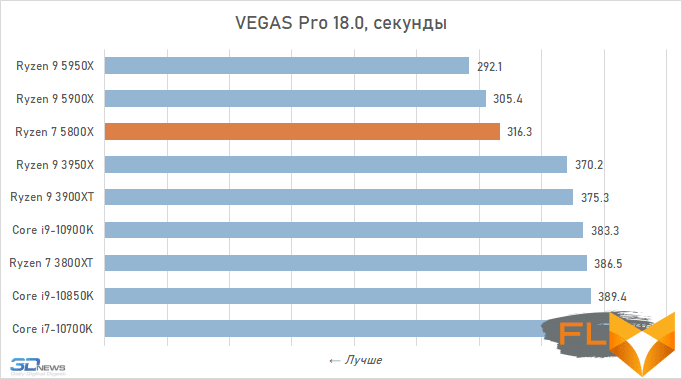
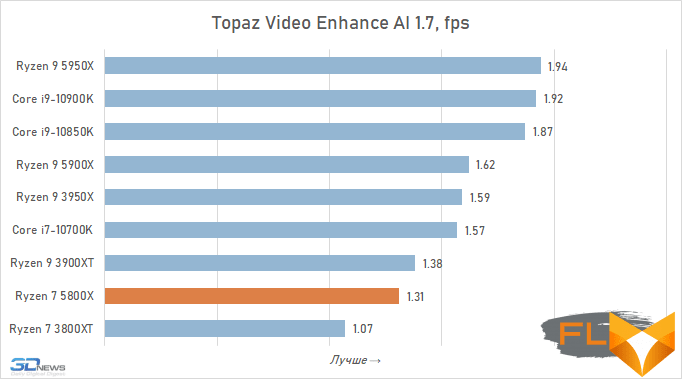
Video transcoding:
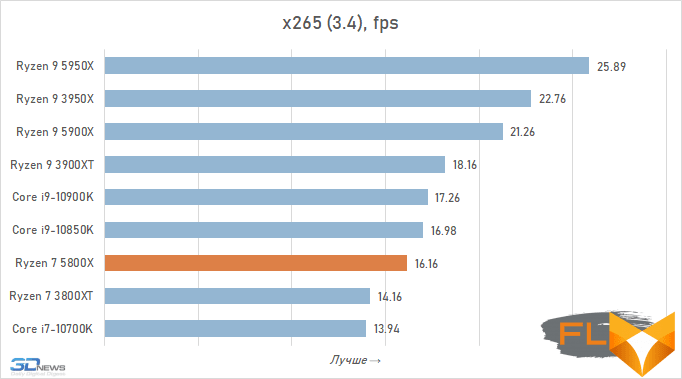
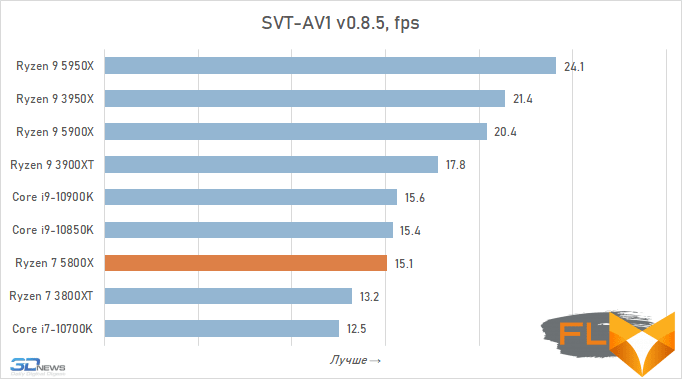
Compilation:
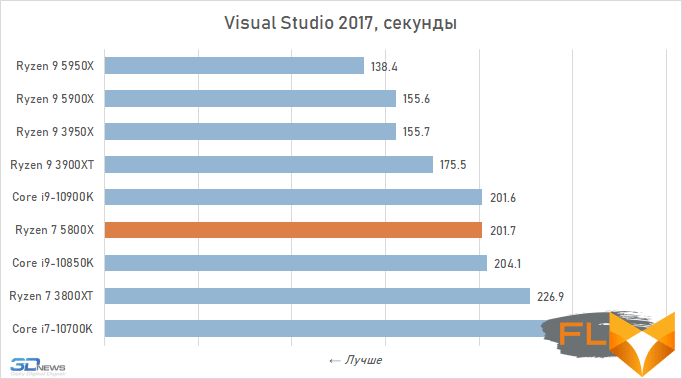
Archiving:
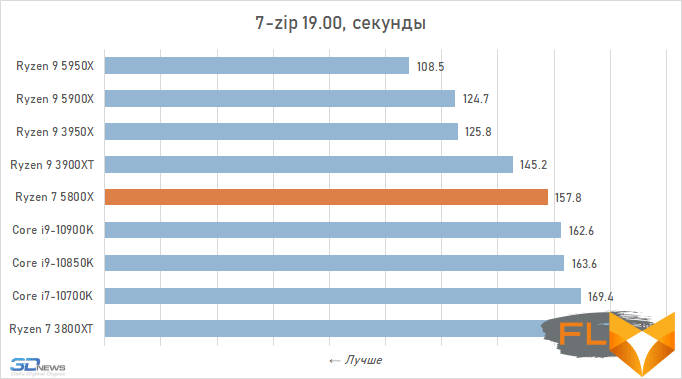
Chess:
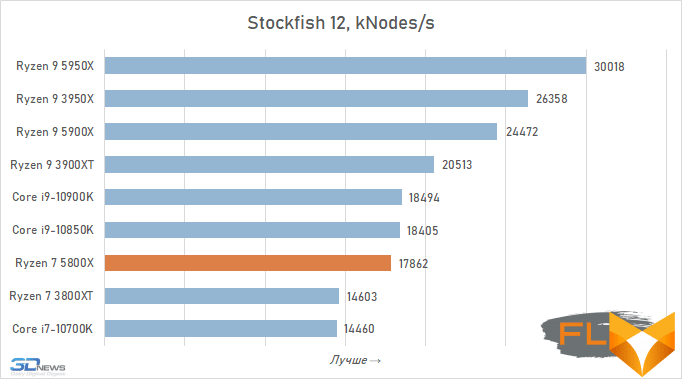
Encryption:
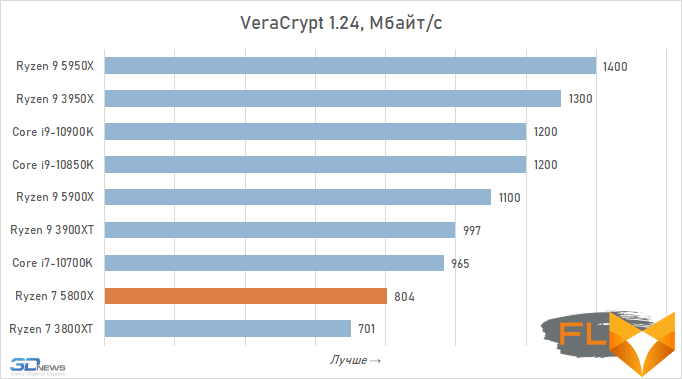
⇡#Performance in games. Tests in 1080p
Gaming performance is where processors based on the Zen 3 microarchitecture have benefited particularly strongly. Here, along with the growth of the IPC indicator, the combination of eight cores and 32 MB of L3 cache in one CCX complex at once played a big role. As a result, any global lag behind Intel processors has disappeared, and the Ryzen 7 5800X is a great illustration of this: its gaming performance is almost as good as that of the Ryzen 9 5900X. However, the hopes that the octa-core processor will become AMD’s best gaming processor due to the internal structure with a single CCD did not materialize. In practice, the Ryzen 9 5900X is still slightly faster, apparently due to twice the total amount of L3 cache. For example, if we talk about the average frame rate in FullHD resolution, then the 12-core AMD processor overtakes the protagonist of this review by about 2%.
Nor can it be said that the Zen 3 microarchitecture made the Ryzen 7 5800X a better foundation for gaming systems than Intel’s Comet Lake family of processors. Exactly the same thing is observed as we talked about in the last section: in terms of performance, the eight-core Ryzen 7 5800X roughly corresponds to the ten-core Core i9-10900K (or Core i9-10850K). Somewhere the AMD version is faster, as, for example, in Civilization VI, Crysis Remastered or World War Z, and somewhere the Intel processor provides a higher FPS, for example, in Far Cry New Dawn, Metro Exodus or Watch Dogs Legion. In other words, the choice of good processors for gaming systems has now expanded significantly, and this is very timely, since there is a clear shortage of high-performance components on the market.
The following graph shows the average FPS we got from our tests in 10 games.
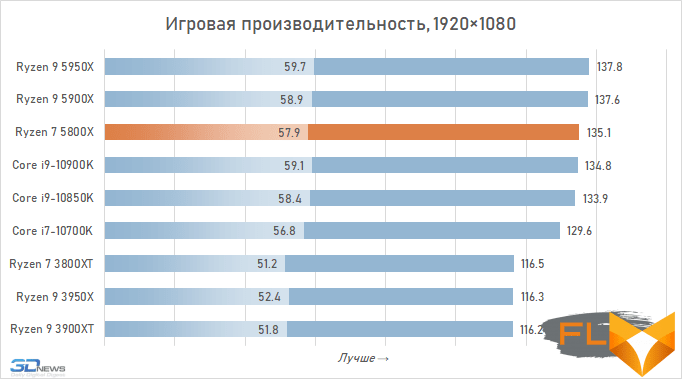
And then you can get acquainted with more detailed results for each game separately.
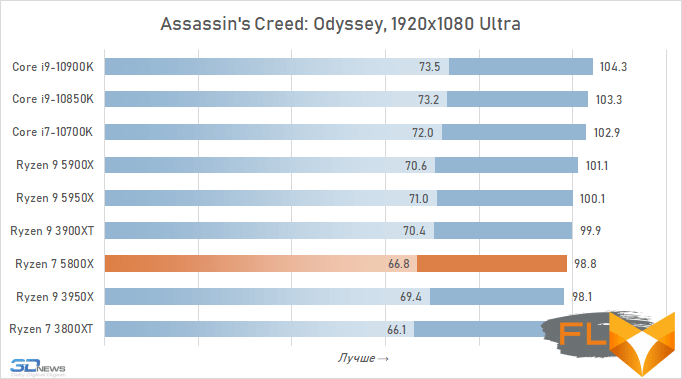
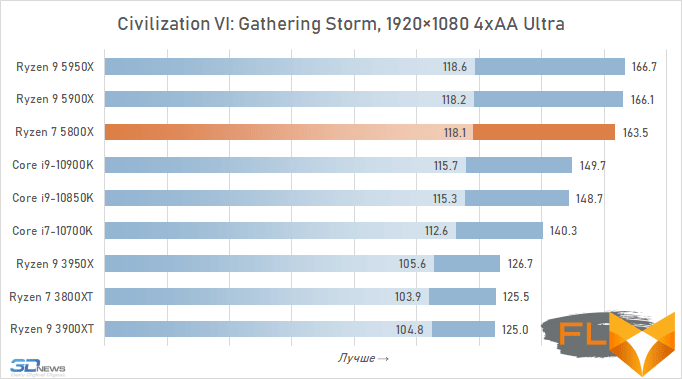
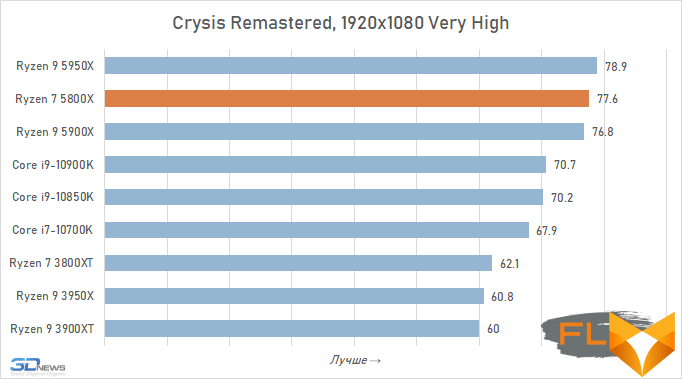
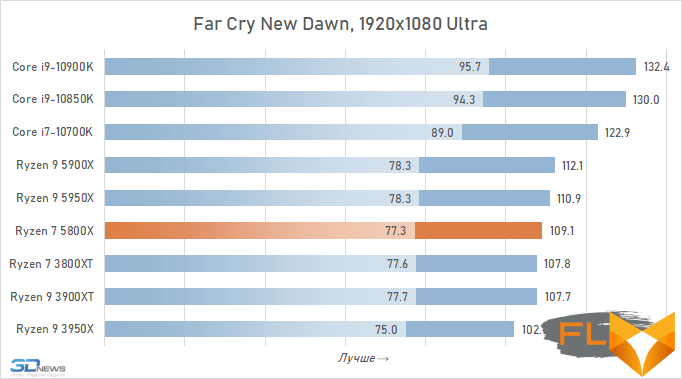
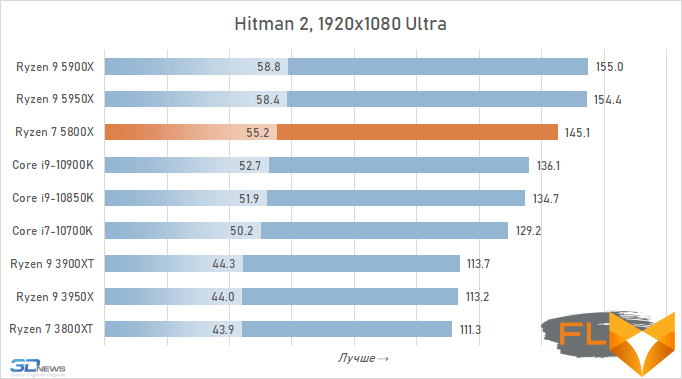
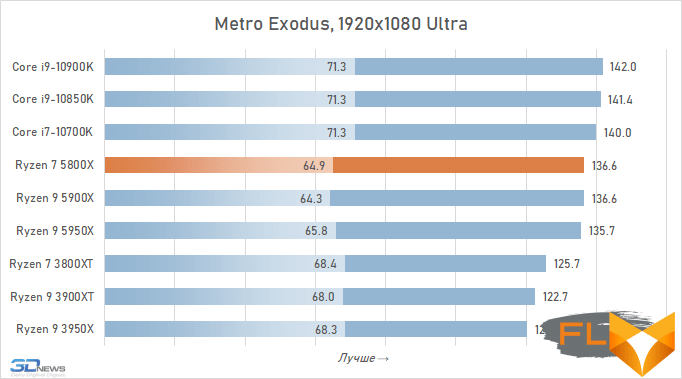
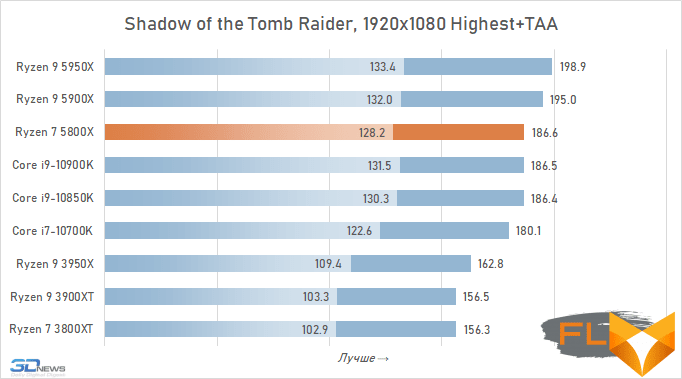
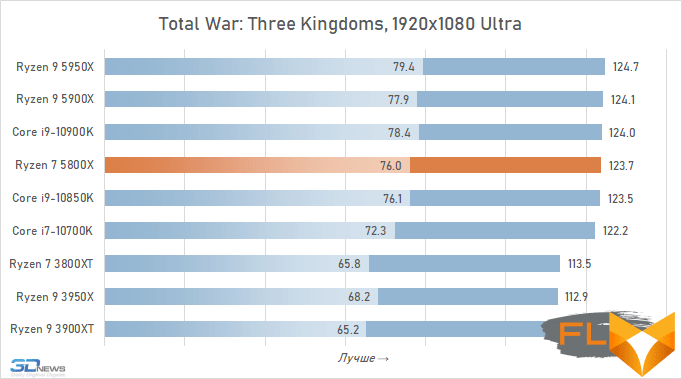
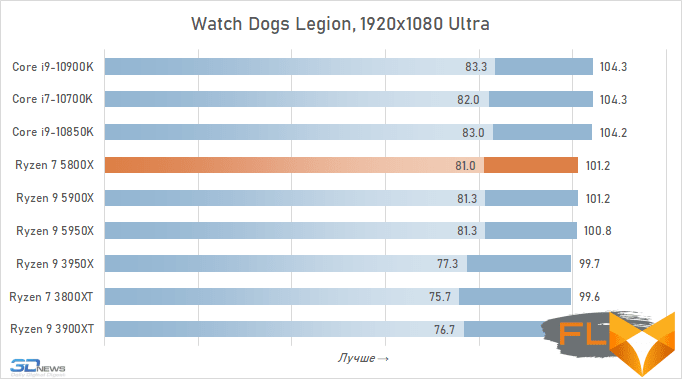
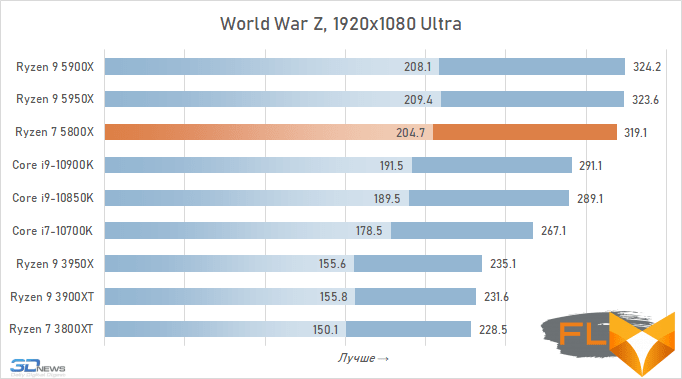
⇡#Performance in games. Tests in 2160p
As the resolution increases while maintaining high quality settings in games, the CPU starts to play a much smaller role, so in most of the graphs below you will not see noticeable differences in frame rates. All participating CPUs in this test have enough power to pull graphics in 4K. Actually, this is the main conclusion in this section: the Ryzen 7 5800X is a great choice for the ultimate gaming system aimed at working at maximum resolution, but there are other options that also work well in this case.
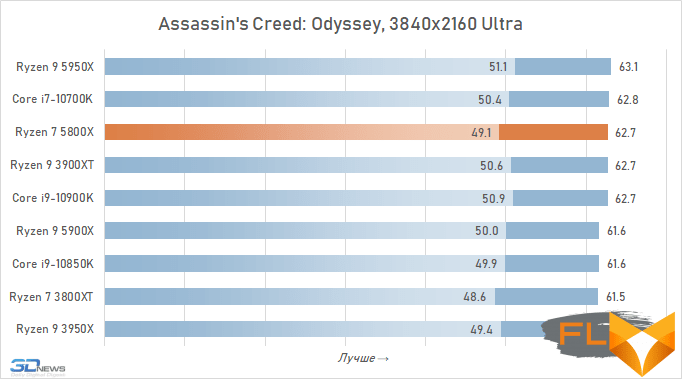
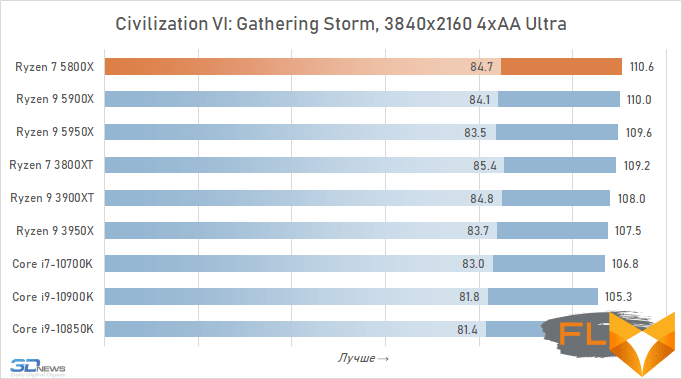
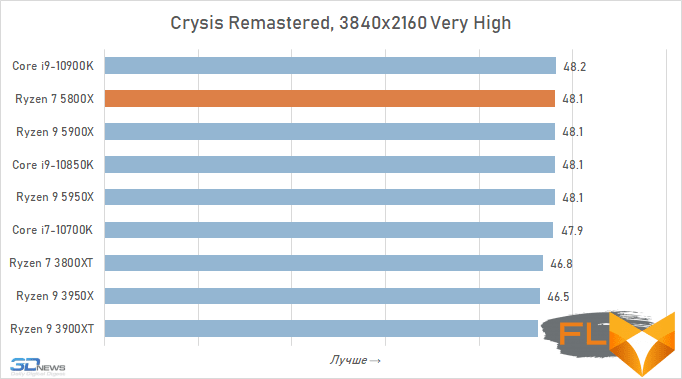
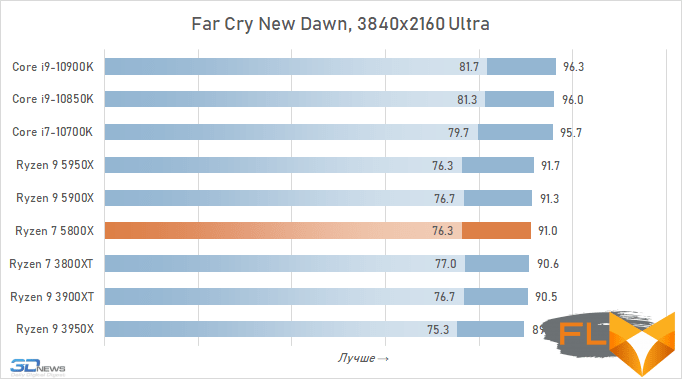
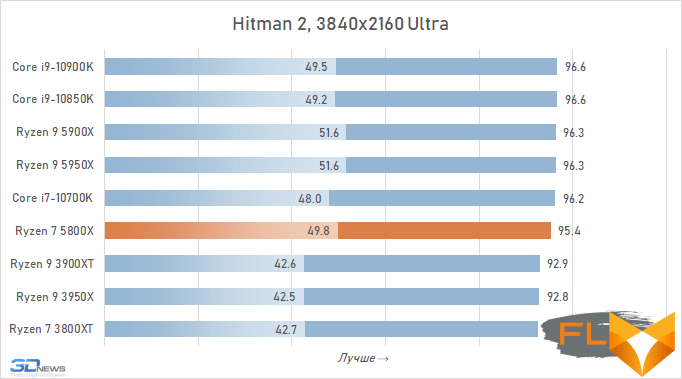
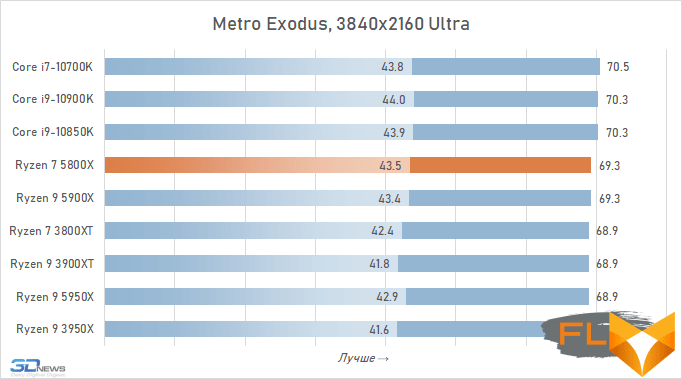
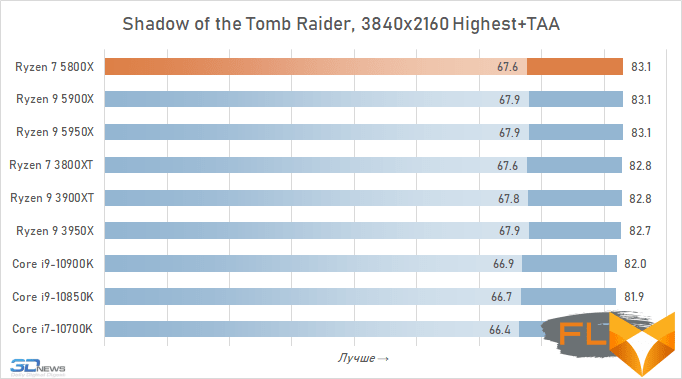
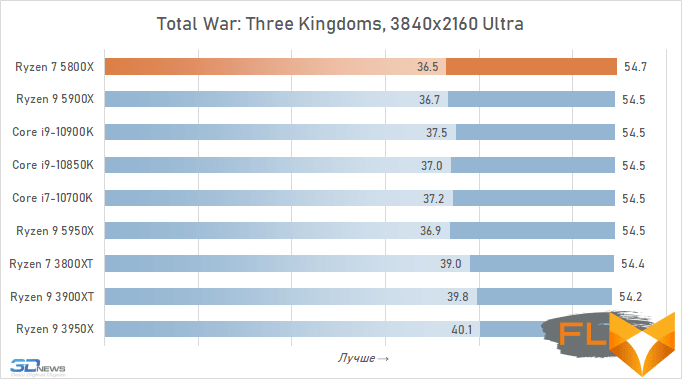
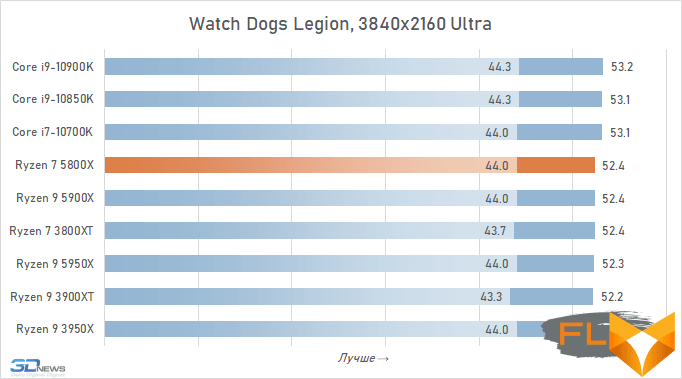
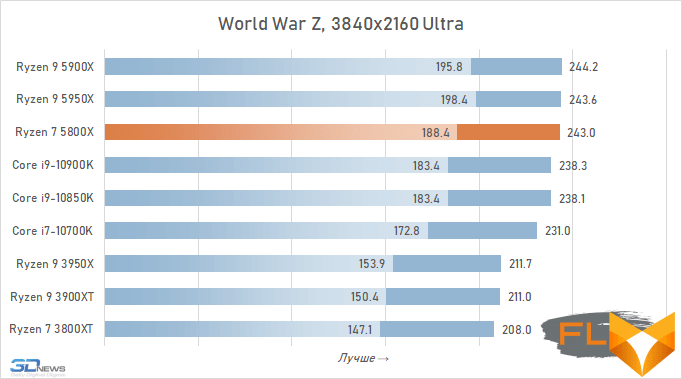
⇡#Power Consumption
Testing the power consumption of today’s high-performance AMD processors is becoming less and less interesting. The point is in Precision Boost technology, which dynamically adjusts CPU operating parameters, such as frequency and voltage, adjusting power consumption to a value predetermined in the specifications. In practice, this means that all multi-core Ryzen processors with a thermal package of 105 W consume about 142 W of electricity under a resource-intensive load, and systems based on them turn out to be very similar in terms of total power consumption.
Comparing Ryzen in this sense is only interesting with Core processors, although the result is predictable here too. It is quite obvious that AMD processors, which are manufactured using 7nm technology, are superior in energy efficiency to competitors from the blue camp. Moreover, in the latest generations of its CPUs, Intel has purposefully turned a blind eye to power consumption for the sake of higher operating frequencies.
The graphs below make it all clear. They show the total consumption of systems (without monitors) with the corresponding processors, measured “after” the power supply, which is the sum of the power consumption of all components involved in the system. The efficiency of the power supply itself in this case is not taken into account.
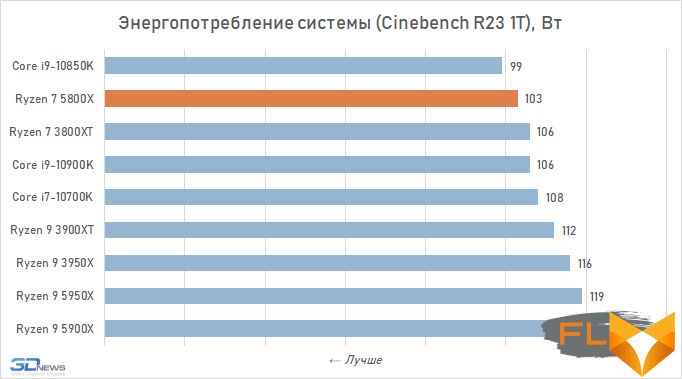

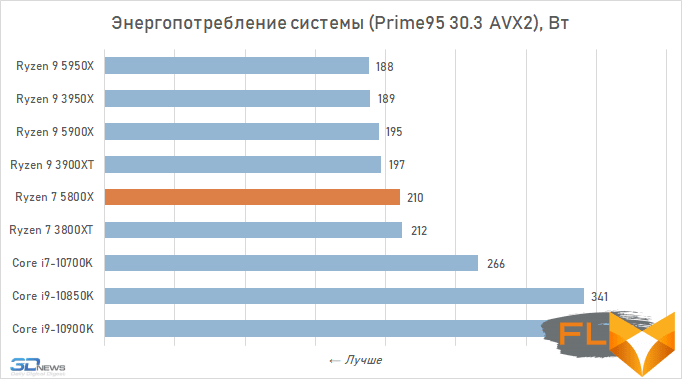
It is worth noting that only the 10-core Comet Lake stands out against the backdrop of Ryzen with prohibitively high energy appetites. At the same time, the eight-core Core i7-10700K processor turns out to be comparable in consumption to the Ryzen 7 5800X, but unless we are talking about the AVX load. When executing vector instructions, AMD has a clear advantage in energy efficiency – this is such a feature of the Zen 2 and Zen 3 microarchitectures.
⇡#Conclusions
We talked about how successful the fourth iteration of the Zen microarchitecture was at AMD in the last review when we tested the 12- and 16-core. For the eight-core processor Ryzen 7 5800X, to which this review is dedicated, all these theses are also true. AMD has indeed improved performance by double digits over the previous generation and has indeed corrected Zen 2’s main shortcoming – high inter-core communication latencies. As a result, the new octa-core Ryzen 7 5800X looks impressive compared to its predecessor, the Ryzen 7 3800XT. Average performance in resource-intensive applications increased by 17%, average performance in games (at maximum settings in FullHD) increased by almost 20%, and power consumption did not change. This is really a major breakthrough, which is sorely lacking in the recent history of x86 processors.
Ultimately, it’s no exaggeration to say that the Ryzen 7 5800X is the fastest octa-core processor to date. It surpasses not only its eight-core relatives, but also those processors that Intel offers in this weight category. And for the first time, we can say this not only in relation to resource-intensive computing tasks, but also about games, where the Ryzen 7 5800X really looks a little better than the Core i7-10700K.
All this could make a real bestseller out of the Ryzen 7 5800X, if not for one thing. The price of this processor is such that it has to be opposed not to the competitor’s eight-core processors, but to the ten-core Core i9-10900K and Core i9-10850K processors. And with such a comparison, it is no longer necessary to talk about the unequivocal superiority of the Ryzen 7 5800X. These are solutions comparable in speed, but no more.
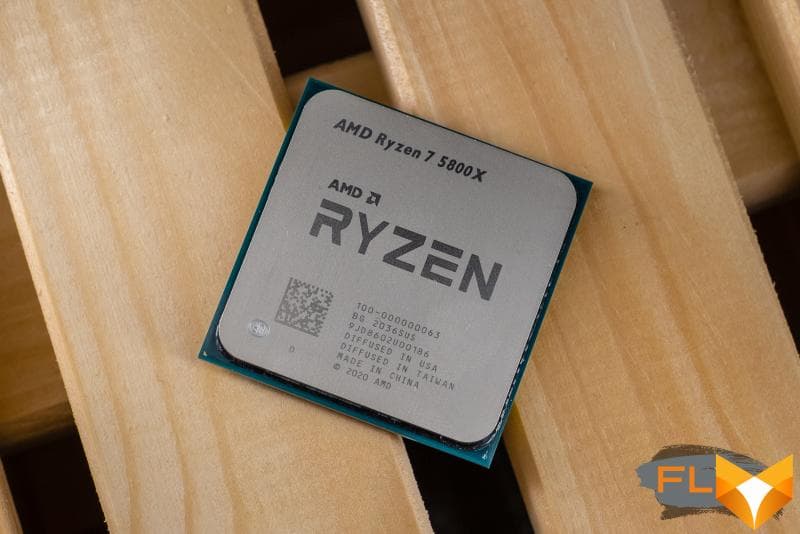
Thus, if when testing the Ryzen 9 5900X and Ryzen 9 5950X, we could say about the convincing victory of AMD in the upper market segment, then, shifting the focus to the $400-$500 price range, we have to change the tone a little. The Ryzen 7 5800X is a really good processor, but fans of Intel products can get about the same performance on about the same budget. The only thing the Ryzen 7 5800X is better than the 10-core Intel Core family is energy efficiency, but it can also shock its owners with prohibitive operating temperatures.
In addition, buying a Ryzen 7 5800X today at a price close to the official one is not an easy task. Therefore, we will refrain from making any recommendations for now, but when the situation with availability and prices normalizes, we will return to discussing the market prospects of the Ryzen 7 5800X.
In conclusion, I would like to ask AMD to release a cheaper and cooler version of the eight-core processor with the Zen 3 microarchitecture – the conditional Ryzen 7 5700X, similar to the Ryzen 7 3700X. Unlike the Ryzen 7 5800X, such a processor, most likely, could be praised without any reservations. But the emergence of such a “perfect eight-core” will have to wait at least a few more months, because before expanding the lineup, AMD must cope with the shortage that arose against the background of the pandemic and the release of next-generation consoles.

